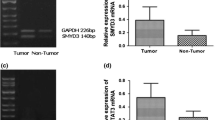Abstract
Recently, stathmin 1 has been proposed to function as an oncogene based on some relevant studies in multiple types of human cancers. However, the role of stathmin 1 in gastric cancer carcinogenesis has not been elucidated yet. The aim of this study was to investigate the expression of stathmin 1 as well as its association with overall survival of gastric cancer patients. The expression of stathmin 1 was detected by real-time quantitative reverse transcription polymerase chain reaction and Western blotting in gastric cancer and adjacent nontumor tissues. In addition, stathmin 1 expression was analyzed by immunohistochemistry in paraffin samples from 210 primary gastric cancer patients. The expression levels of stathmin 1 mRNA and protein in gastric cancer tissues were both significantly higher than those in adjacent nontumor tissues. In addition, the expression of stathmin 1 is correlated with Lauren’s classification, depth of invasion, lymph node metastases, and tumor node metastasis (TNM) stage (all P < 0.05). Univariate analysis showed that high stathmin 1 expression was associated with poor prognosis in gastric cancer patients (P = 0.040). Multivariate analysis demonstrated that only lymph node metastasis and TNM stage were the independent prognostic indicators for gastric cancer. Stathmin 1 expression status is not an independent prognostic factor for patients with gastric cancer. Further subgroup analysis revealed that stathmin 1 expression was significantly correlated with prognosis in diffuse type gastric cancer. This research showed that the stathmin 1 overexpression might play an important role in the pathogenesis and subsequent progression of gastric cancer. Stathmin 1 could also be a potential therapeutic target in gastric cancer, especially for diffuse type gastric cancer.




Similar content being viewed by others
References
Brenner H, Rothenbacher D, Arndt V. Epidemiology of stomach cancer. Methods Mol Biol. 2009;472:467–77.
Lin Y, Ueda J, Kikuchi S, et al. Comparative epidemiology of gastric cancer between Japan and China. World J Gastroenterol. 2011;17(39):4421–8.
Liu D, Zhang Z, Kong CZ. High FOXM1 expression was associated with bladder carcinogenesis. Tumour Biol. 2013;34(2):1131–8.
Hu BS, Hu H, Zhu CY, Gu YL, Li JP. Overexpression of GOLPH3 is associated with poor clinical outcome in gastric cancer. Tumour Biol. 2013;34(1):515–20.
Belletti B, Baldassarre G. Stathmin: a protein with many tasks. New biomarker and potential target in cancer. Expert Opin Ther Targets. 2011;15(11):1249–66.
Curmi PA, Gavet O, Charbaut E, et al. Stathmin and its phosphoprotein family: general properties, biochemical and functional interaction with tubulin. Cell Struct Funct. 1999;24(5):345–57.
Charbaut E, Curmi PA, Ozon S, Lachkar S, Redeker V, Sobel A. Stathmin family proteins display specific molecular and tubulin binding properties. J Biol Chem. 2001;276(19):16146–54.
Rubin CI, Atweh GF. The role of stathmin in the regulation of the cell cycle. J Cell Biochem. 2004;93(2):242–50.
Howell B, Larsson N, Gullberg M, Cassimeris L. Dissociation of the tubulin-sequestering and microtubule catastrophe-promoting activities of oncoprotein 18/stathmin. Mol Biol Cell. 1999;10(1):105–18.
Melhem R, Hailat N, Kuick R, Hanash SM. Quantitative analysis of Op18 phosphorylation in childhood acute leukemia. Leukemia. 1997;11(10):1690–5.
Bhagirath D, Abrol N, Khan R, Sharma M, Seth A, Sharma A. Expression of CD147, BIGH3 and Stathmin and their potential role as diagnostic marker in patients with urothelial carcinoma of the bladder. Clin Chim Acta. 2012;413(19–20):1641–6.
Su D, Smith SM, Preti M, et al. Stathmin and tubulin expression and survival of ovarian cancer patients receiving platinum treatment with and without paclitaxel. Cancer. 2009;115(11):2453–63.
Xi W, Rui W, Fang L, Ke D, Ping G, Hui-Zhong Z. Expression of stathmin/op18 as a significant prognostic factor for cervical carcinoma patients. J Cancer Res Clin Oncol. 2009;135(6):837–46.
Baquero MT, Hanna JA, Neumeister V, et al. Stathmin expression and its relationship to microtubule-associated protein tau and outcome in breast cancer. Cancer. 2012;118(19):4660–9.
Rosell R, Scagliotti G, Danenberg KD, et al. Transcripts in pretreatment biopsies from a three-arm randomized trial in metastatic non-small-cell lung cancer. Oncogene. 2003;22(23):3548–53.
Jeon TY, Han ME, Lee YW, et al. Overexpression of stathmin1 in the diffuse type of gastric cancer and its roles in proliferation and migration of gastric cancer cells. Br J Cancer. 2010;102(4):710–8.
Kang W, Tong JH, Chan AW, et al. Stathmin1 plays oncogenic role and is a target of microRNA-223 in gastric cancer. PLoS One. 2012;7(3):e33919.
Tang Y, Dai Y, Huo J. Decreased expression of T-cadherin is associated with gastric cancer prognosis. Hepatogastroenterology. 2012;59(116):1294–8.
Alli E, Yang JM, Ford JM, Hait WN. Reversal of stathmin-mediated resistance to paclitaxel and vinblastine in human breast carcinoma cells. Mol Pharmacol. 2007;71(5):1233–40.
Hsieh SY, Huang SF, Yu MC, et al. Stathmin1 overexpression associated with polyploidy, tumor-cell invasion, early recurrence, and poor prognosis in human hepatoma. Mol Carcinog. 2010;49(5):476–87.
Conflicts of interest
None.
Author information
Authors and Affiliations
Corresponding authors
Additional information
Bin Ke and Liang-Liang Wu contributed equally to this study.
Rights and permissions
About this article
Cite this article
Ke, B., Wu, LL., Liu, N. et al. Overexpression of stathmin 1 is associated with poor prognosis of patients with gastric cancer. Tumor Biol. 34, 3137–3145 (2013). https://doi.org/10.1007/s13277-013-0882-0
Received:
Accepted:
Published:
Issue Date:
DOI: https://doi.org/10.1007/s13277-013-0882-0




